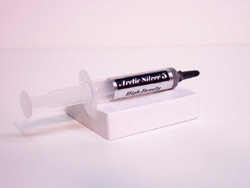Thermal Paste and How To Use It |
|
Introduction
Whenever you install a heatsink on a CPU or a video card, you always have to apply thermal paste. It is very crucial to the performance of the heatsink. You could get a very high-end heatsink, and without thermal paste, it will fail to work in the way it was designed too.What is thermal paste and what does it do?
Thermal paste is a very high heat conductive paste that is used between two objects (usually a heatsink and a CPU/GPU) to get better heat conduction. It fills in all those microscopic imperfections on the heatsink and CPU/GPU that can trap air in them and cause a loss in the heatsink’s performance. Air is a very poor conductor of heat. Thermal Interface Materials (TIM) can be up to a 100 times greater conductor of heat than air.However, thermal paste is not near as good of a conductor as copper. Thus, too much thermal paste will hinder a heatsink’s ability to cool properly.

This is an exaggerated view of what these microscopic imperfections would look like. All the white area would represent the air pockets, and this is what the TIM would fill in. It wouldn't be such a gap like this, but this just an example to give you a rough idea of what it would look like.
If you could have a perfectly flat heatsink base, and CPU, you would not need thermal paste. But it is impossible to do so, and that’s why we need thermal paste.
Types of thermal paste
There are essentially three types of thermal pastes:- Metal based
- Ceramic based
- Silicon based

Ceramic-based TIM’s are also a popular solution that doesn’t perform quite as well as metal-based pastes, but the difference is minimal (1-3C). These consist of some form of thermally conductive material with lots of little ceramic particles. The advantage of ceramic-based pastes is that they do not conduct electricity.

Silicon-based TIM’s are usually what thermal pads that come on stock heatsinks are made of. These work well, but nowhere near to what other pastes will. Usually they come with cooling kits.

There are also thermal epoxies, these are basically the same thing as regular grease, but are actually used to permanently attach the heatsink. They are not recommended for most cases, but in some they are of course. One main example for a use of an epoxy is, attaching heatsinks to video memory. Most of the time you use thermal pads that don’t perform very well, so an alternative is thermal epoxy. But the disadvantage is, that most of the time you will not get the heatsinks off once they are put on.
What can be tried to get epoxied heatsinks off is to put the video card in the freezer before trying to remove the heatsink. The low temperature will make the epoxy brittle, so it goes off easier.
Jan 20th, 2025 13:49 EST
change timezone
Latest GPU Drivers
New Forum Posts
- Asus Proart PA602 Compatibility with Corsair RM1200X Shift (16)
- Slot for a TPM module (0)
- Very inconsistent frames (10)
- Cryptocoin Value and Market Trend Discussion (1578)
- ThrottleStop 9.7 - V/F Point (3)
- RX580 not stable... (8)
- Game of the year 2024 (86)
- What's your latest tech purchase? (22921)
- for those who think 12gb vram can max out everything (116)
- New build for MSFS2020 (11)
Popular Reviews
- Fosi Audio K7 Gaming Desktop DAC/Headphone Amplifier Review
- NVIDIA GeForce RTX 50 Technical Deep Dive
- ASRock Arc B570 Challenger OC Review
- NVIDIA GeForce RTX 5090 Founders Edition Unboxing
- Montech Heritage Pro Review - The Leather Case
- Sparkle B570 Guardian OC Review
- AMD Ryzen 7 9800X3D Review - The Best Gaming Processor
- be quiet! Light Loop 360 mm AIO Review
- G-Wolves Hati-S2 8K Review
- NZXT C1500 Review
Controversial News Posts
- NVIDIA 2025 International CES Keynote: Liveblog (468)
- AMD Debuts Radeon RX 9070 XT and RX 9070 Powered by RDNA 4, and FSR 4 (349)
- NVIDIA GeForce RTX 5090 Features 575 W TDP, RTX 5080 Carries 360 W TDP (217)
- AMD Radeon RX 9070 XT & RX 9070 Custom Models In Stock at European Stores (214)
- AMD Radeon RX 9070 XT Alleged Benchmark Leaks, Underwhelming Performance (204)
- Potential RTX 5090 and RTX 5080 Pricing in China Leaks (173)
- AMD Radeon RX 9070 XT Tested in Cyberpunk 2077 and Black Myth: Wukong (169)
- AMD Radeon RX 9070 XT Boosts up to 3.10 GHz, Board Power Can Reach up to 330W (167)